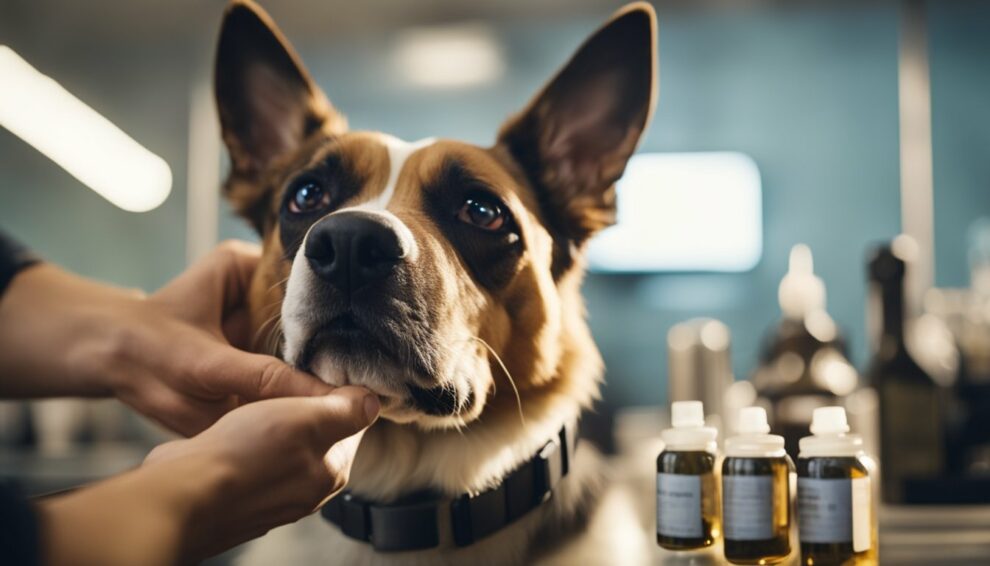Ear mites in dogs can be quite a nuisance, causing discomfort and potential complications if not addressed in a timely manner.
As pet owners, we all want to ensure our furry friends are happy and healthy.
Discovering your dog is scratching incessantly at their ears is a sign you might be dealing with an ear mite infestation.
It’s a common problem, but fortunately, there are several effective home treatments we can use to tackle these pesky parasites.

In treating ear mites at home, we aim not only to eliminate the current mites but also to prevent future outbreaks.
Before we administer any treatments, it is crucial for us to confirm that ear mites are the actual cause of the irritation.
Once diagnosed, we can employ gentle yet effective remedies, such as olive oil or mineral oil treatments, to suffocate mites and provide relief to our dog’s ears.
It’s important to approach these treatments with care, ensuring we’re not causing our pups any additional discomfort.
By staying informed and attentive, we can help our furry companions shake off the mites and get back to their cheerful selves.
Identifying Ear Mites in Dogs

Before we can treat our canine friends for ear mites, it’s critical to correctly identify the presence of these tiny parasites.
We’ll look at both the symptoms to watch out for and the ways to distinguish ear mites from other ear infections.
Symptoms and Detection
Ear mites in dogs are notorious for causing a series of distinctive symptoms that are hard to miss.
Our dogs may begin to scratch their ears excessively, or you might notice them shaking their heads more often than usual.
The presence of a dark, waxy discharge within the ears is a common tell-tale sign.
Here are some of the symptoms that should prompt us to investigate further:
- Excessive scratching near the ears
- Head shaking
- Discharge resembling coffee grounds
- Inflammation or redness inside the ear
- An unpleasant smell coming from the ears
- Possibly visible tiny white dots (mites) moving in the ear canal
If we see these signs, it’s time to check in with our vet.
They can make an accurate diagnosis using an otoscope to look deep into the ear canal, where these mites like to live and feed.
Differences Between Mites and Infections
It’s also important for us to differentiate between ear mites and other types of ear infections.
While ear mites produce a dry, black or brown wax, bacterial infections might result in a yellowish or greenish discharge.
Also, while the symptoms of ear mites and ear infections can overlap—like scratching, discharge, and inflammation—bacteria or yeast infections usually don’t cause the presence of the crumbly material typical of mites.
If we’re unsure, a vet will often perform a diagnosis by examining the discharge under a microscope to identify whether mites, bacteria, or yeast are the culprits.
Preparing for Home Treatment

When we’re ready to treat our furry friends at home for ear mites, it’s crucial we prioritize their safety and comfort.
Let’s prepare properly to ensure our treatment is as effective as it can be without causing any additional distress.
Safety Measures and Considerations
First, we need to ensure that the treatment we choose is safe and appropriate for our dog.
It’s vital to consult with a veterinarian before starting any treatment, especially if we’re planning to use products like hydrogen peroxide or vinegar, which can cause irritation.
Always use the proper concentration, as recommended by professionals, to avoid any potential harm.
Never insert a Q-tip deep into the ear canal, as this can cause pain and potentially damage the ear.
When applying any treatment, including mineral oil or an antiseptic, we need to confirm that our dog is not showing any signs of severe pain or discomfort which might necessitate immediate medical attention.
If our pooch is in distress, it’s better to seek professional help rather than attempting home treatment.
Cleaning the Dog’s Ears
Cleaning is a critical step in the treatment process.
To begin, we’ll gather our materials: a good quality ear cleaning solution recommended by our vet, cotton balls or soft pads, and gloves.
Here’s how we’ll proceed:
-
Prepare the Solution: If the vet has recommended a homemade solution, like a diluted vinegar mix, we’ll prepare that first.
For store-bought solutions, we’ll have them ready to go.
-
Restrain Gently: We’ll calmly hold our dog still, reassuring them throughout the process to minimize stress.
-
Clean Outer Ear: Dampen a cotton ball with the cleaning solution.
Gently wipe the outer part of the ear to remove any visible debris or discharge.
It’s important not to force the cotton ball into the ear canal.
-
Apply Treatment: If we’re using an oil-based treatment like mineral oil, we’ll carefully apply a few drops to the entrance of the ear canal, massaging the base of the ear to ensure distribution.
-
Remove Excess: After a few minutes, we’ll wipe away any excess solution and dislodged debris with a fresh cotton ball, being careful not to press deeply into the ear canal.
By taking these steps, we’ll create a clean environment that’s less hospitable to mites and more comfortable for our dog.
Home Remedy Options

When we talk about treating ear mites in our furry friends at home, we focus on two main approaches: Natural Oils and Extracts, and Homemade Mixtures.
These remedies use ingredients known for their natural antiseptic, antibacterial, and antiviral properties, offering a gentle yet effective way to combat ear mites.
Natural Oils and Extracts
- Olive Oil: A few drops of warm olive oil placed directly in the dog’s ear canal can help to soothe irritation and smother ear mites.
- Tea Tree Oil: Diluted tea tree oil can be potent due to its antiseptic qualities, but must be used with caution as it can be too strong for some dogs.
- Green Tea: A natural antiseptic, green tea can be brewed, cooled, and used to flush out debris caused by ear mites.
- Apple Cider Vinegar: With its antibacterial and antiviral properties, diluted apple cider vinegar can be used to cleanse the ear and restore its natural pH.
Please note that when using oils and extracts, it’s essential to ensure that they are properly diluted and not used in excessive amounts, as they might cause further irritation.
Homemade Mixtures
- Vinegar and Water: Mix equal parts of apple cider vinegar and water to create a homemade dog ear cleaner that can help with ear mites.
- Herbal Antiseptic Rinse: Combine anti-parasitic herbs like yellow dock with warm water for a soothing ear rinse.
- Boracic Acid Mixture: Boracic acid can be an effective ingredient against ear mites when mixed with water, but it’s critical to use the correct proportions to avoid irritation.
In using these homemade mixtures, we always pay attention to our dog’s reactions and consult a vet if we’re in doubt about the suitability of the remedy.
Safe application and gentle care are paramount in our efforts to clear those pesky ear mites.
Administering Treatments and Aftercare

When it comes to treating ear mites in our furry friends, we need to be diligent with application techniques and ensure there’s a consistent follow-up to prevent further infections.
Application Techniques
To effectively tackle ear mites, we use specific application techniques.
Firstly, we ensure the dog’s ears are clean and debris-free.
Using a veterinarian-approved ear mite treatment, we carefully follow the instructions, which typically involve:
- Applying a designated number of drops into the ear canal
- Massaging the base of the ear gently to spread the medication
- Wiping away any excess product to avoid unnecessary mess
It’s essential to treat all of our pets, as ear mites can spread quickly among them.
Monitoring and Follow-Up
Monitoring and follow-up are crucial in preventing ear mite recurrence and secondary infections.
We observe our dogs for any signs of discomfort or persistent symptoms and schedule a follow-up visit with the vet to ensure the ear mites are gone.
Follow-up usually includes:
- A visual check of the ears for mites or any indication of infection
- Additional cleaning or treatment based on the vet’s advice
We also keep up with regular ear cleaning as a prevention method, making sure to introduce it as a regular part of our pet care routine.
Understanding and Preventing Reinfestation
In our fight against ear mites in dogs, understanding how these parasites spread and establishing robust preventative measures are crucial steps to ensure our furry friends remain healthy and comfortable.
Sources of Ear Mites
Ear mites, specifically Otocodex cynotis, are highly contagious parasites that thrive in the ear canals of pets, especially dogs and cats.
An infestation typically begins when our pet comes into close contact with an already infested animal.
Shared spaces and bedding can also be hotspots for these mites to transfer from one pet to another.
- Contact with other pets: Above all, the most common source of mites is direct contact with an infected animal.
This means play dates and dog parks can pose a risk.
- Shared bedding and furniture: If one of our pets has an infestation, mites can linger on bedding or furniture and can be picked up by another pet.
Preventative Strategies
To prevent ear mites from taking hold, we must proactively adopt a range of prevention strategies that break the cycle of reinfestation.
Proper cleaning and regular checks are part of the solution.
-
Regular Cleaning: Keeping our pets’ living environments clean is vital.
Regular washing of bedding, toys, and any shared pet furniture can help eliminate mites.
- Bedding: Wash your dog’s bedding in hot water weekly.
- Cleaning routine: Incorporate the cleaning of communal pet areas into our weekly household chores.
-
Prevention Treatments: Certain products can be used for mite prevention.
- Medicated drops: A veterinarian might recommend medicated drops that can be applied as a preventative measure.
- Monthly topical products: There are topical treatments designed to repel a variety of parasites, including ear mites, which can be applied monthly to your dog’s skin.
Remember, regular vet check-ups will give us the opportunity to catch any early signs of infestation, so we can tackle the issue before it becomes more serious.
By being vigilant and maintaining good hygiene, we can make sure that reinfestations are less likely to occur in our household.















